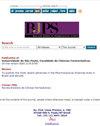Moderate Toxicity of Potential Boron-containing Therapeutic, Dipotassium-trioxohydroxytetrafl uorotriborate -K2(B3O3F4OH) in Rats and Mice
IF 0.9
4区 医学
Q4 PHARMACOLOGY & PHARMACY
引用次数: 0
Abstract
Biological activity of boron-containing compounds (BCCs) has been well-known. Growing interest and numerous applications for BCCs have been reported. Boron and boron-containing acids show low acute toxicity in mammals but data on halogenated boroxine (HB) - dipotassium-trioxohydroxytetrafluorotriborate, K 2 (B 3 O 3 F 4 OH) acute toxicity have not been reported before. This compound, characterized as a potential therapeutic for skin changes, exhibits no observable genotoxicity in doses lower that 0.1 mg/ml in vitro and 55 mg/kg in vivo. It has also been confirmed as an antitumour agent both in vitro and in vivo as well as an inhibitor of enzymes involved in antioxidant mechanisms. The aim of this study was to assess the acute toxicity of HB and to determine the maximum tolerated dose as well as a dose free of any signs of toxicity in different test organisms. Acute toxicity of HB was tested in Sprague-Dawley and Wistar rats and BALB/c mice after single parenteral application of different doses. We determined doses free of any sign of toxicity and LD 50 after single dose administration. LD 50 of HB ranges from 63 to 75 mg/kg in different test models, meaning that HB shows moderate toxicity.潜在的含硼治疗药物二钾-三氧羟基四氟三硼酸钾-K2(B3O3F4OH)对大鼠和小鼠的中度毒性
本文章由计算机程序翻译,如有差异,请以英文原文为准。
求助全文
约1分钟内获得全文
求助全文
来源期刊

Brazilian Journal of Pharmaceutical Sciences
PHARMACOLOGY & PHARMACY-
CiteScore
1.40
自引率
0.00%
发文量
165
审稿时长
7.5 months
期刊介绍:
The Brazilian Journal of Pharmaceutical Sciences accepts for publication Original Papers applicable to the fields of Pharmaceutical Sciences; Reviews and Current Comment Articles, which are published under the Scientific Editor and Associate Editors invitation to recognized experts or when they are spontaneously submitted by the authors in the form of abstracts to have their importance evaluated. A critical view of the subject with insertions of results of previous works in the field in relation to the state of art must be included; Short Communications reporting new methods and previews of works on researches of outstanding importance in which originality justify a quick publication. A maximum of 2000 words excluding tables, figures and references is an acceptable limit. One table, one figure and ten references may be added, and Book Reviews of the latest editions of books, prepared by specialists invited by the Scientific Editor and Associate Editors. Thematic Supplements as well as those related to scientific meetings can be published under the Scientific Editor and/or Associate Editors agreement.
 求助内容:
求助内容: 应助结果提醒方式:
应助结果提醒方式:


